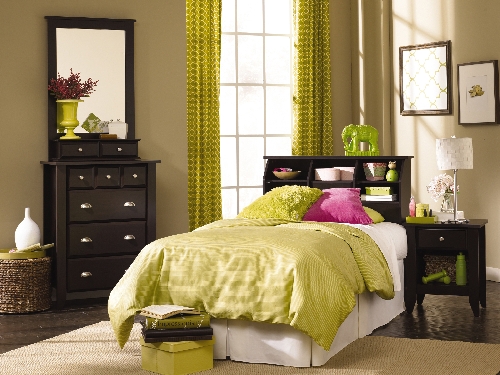Beyond Bohemian

Let’s be honest: Shoppers who set out to find “earth-friendly” or “green” furniture can turn up some pretty quirky products.
A recent online search produced a host of blogs enthusing about paper-pulp furniture — a perfect eco-choice for interiors with a gray, egg carton design motif. Just one week prior, a similar online query generated posts extolling the virtues of “earth-friendly” furniture from Fruit Loops — Fruit Loop boxes, actually – along with any other kind of recycled cereal boxes, which were cleverly crafted into étagère-like room dividers.
At the other end of the eco-furniture scale are high-priced designer collections that include oddities like a $7,000 lounge chair that earns its earth-friendly label because it’s made from recycled, “commemorative” pieces of a famous East Coast boardwalk (old chewing gum painstakingly removed, thank you very much).
Average consumers who work hard to recycle and conserve energy and purchase earth-friendly products whenever possible might wonder if any furnishings exist in the vast middle ground between these two extremes. The good news is, there is plenty in the middle, and the selection is continually growing.
“In fact, eco-friendly home furnishings are now available for every budget and for nearly any style preference,” says Jackie Hirschhaut, vice president of the American Home Furnishings Alliance.
In upholstery, several developments are contributing to the growing selection. More manufacturers are using cushioning materials produced by replacing a portion of the petroleum-based ingredients — usually as much as 20 percent — with a substitute that is made from a renewable source: soy beans. “This innovation was introduced to the furniture industry around 2005, and just five years later it has become the industry standard for eco-friendly upholstery cushions,” Hirschhaut notes.
Also emerging in the upholstered furniture market are new “eco leathers” that use all-natural vegetable dyes and no harmful minerals or metals in the tanning process.
Another option for contemporary upholstery is 100 percent recycled ultramicrofiber fabrics from Toray Ultrasuede. Offered in a wide array of colors and known for their durability and easy maintenance, these earth-friendly fabrics are identified in the marketplace by an EcoDesign logo.
Although these specialty eco-upholstery options currently are used primarily at the upper end of the market, fashion-forward eco choices are growing for more popularly priced upholstery, as well. Many companies now promote “natural” fabrics, like cotton and linen, and an increasing number of upholstery manufacturers are offering additional choices like organic cotton, recycled cotton and hemp.
Other components in upholstery that is labeled “earth friendly” might include
n back and arm padding made with post-consumer recycled fibers;
n springs made from recycled metal;
n frames made from sustainably harvested hardwoods; and,
n water-based wood adhesives.
“Not every manufacturer has the same checklist, but these are the types of components you want to look for if an upholstered product is described as ‘eco-friendly,'” Hirschhaut said.
Shoppers today also will find additional price and style options in eco-friendly wood furniture. “The most critical component in eco-friendly wood furniture is, of course, the wood,” Hirschhaut notes.
An increasing number of manufacturers are touting “certified sustainable” wood, which means the mill from which the wood was purchased has a third-party certification or verification of its sustainability claim. Forest certification programs help ensure that the soil, air, water, wildlife and trees in a forest receive the proper care, and that harvesting and replanting are kept in balance.
Forest Stewardship Council certification is one of the best-known programs worldwide. It enjoys support from the Rainforest Alliance and the World Wildlife Fund, largely due to its focus on environmental protection and social concerns in areas with tropical rainforests. The Sustainable Forestry Initiative is the larger program in North America and is widely recognized by U.S.- and Canadian-based furniture manufacturers.
A third program is growing in importance to U.S. furniture makers because it verifies the sustainability of key lumber sources near their factories. Appalachian Hardwood Verified Sustainable covers 65 million acres of timberland within the 12-state Appalachian Region and uses data from the U.S. Forest Service to document and verify the forest’s sustainability within that region.
Importantly, eco-friendly options in wood furniture also are available to shoppers on a tight budget. Much ready-to-assemble furniture produced in the United States is made from pre- and post-consumer recycled wood scrap.
“More consumers today are looking for earth-friendly furnishings in an effort to live in a more environmentally responsible manner,” Hirschhaut said. “But don’t be swayed by a green logo alone. Do the research and find out whether the manufacturer is taking measurable steps to reduce its environmental footprint and produce a greener furniture product.”
Manufacturers who tout eco-friendly products should also be good corporate environmental stewards.
“So look for an environmental policy statement on their corporate website,” Hirschhaut said. “Beyond the policy statement, what other information do they provide about their operations? If they have an established environmental management system, then you know they have implemented basic sustainable business practices throughout their operations.”
A furniture industry-specific environmental management system is offered by the American Home Furnishings Alliance. It is called EFEC for “Enhancing Furniture’s Environmental Culture,” and companies that have completed the program typically display the EFEC logo on their website. EFEC companies are reviewed annually to ensure continual improvement.
“When you see the EFEC logo, you can be sure the company has taken measurable steps to reduce its environmental impact and is making continual improvements,” Hirschhaut said.
Companies that have implemented the EFEC program include La-Z-Boy (including case goods manufacturers American Drew, Kincaid and Lea Industries), Flexsteel Industries, Hooker Furniture (including Sam Moore and Bradington Young upholstery divisions), Bassett Upholstery, Century Furniture, C.R. Laine, Fairfield Chair and Vaughan-Bassett.
In addition, Furniture Brands International recently announced 24 separate facilities operated by Lane, Thomasville, Broyhill, Henredon, Drexel Heritage, Maitland Smith, Pearson and Laneventure, along with the Furniture Brands corporate headquarters in St. Louis, Mo., will implement the EFEC program. One Furniture Brands company, Hickory Chair, completed EFEC in 2008.
Courtesy American Home Furnishings Alliance